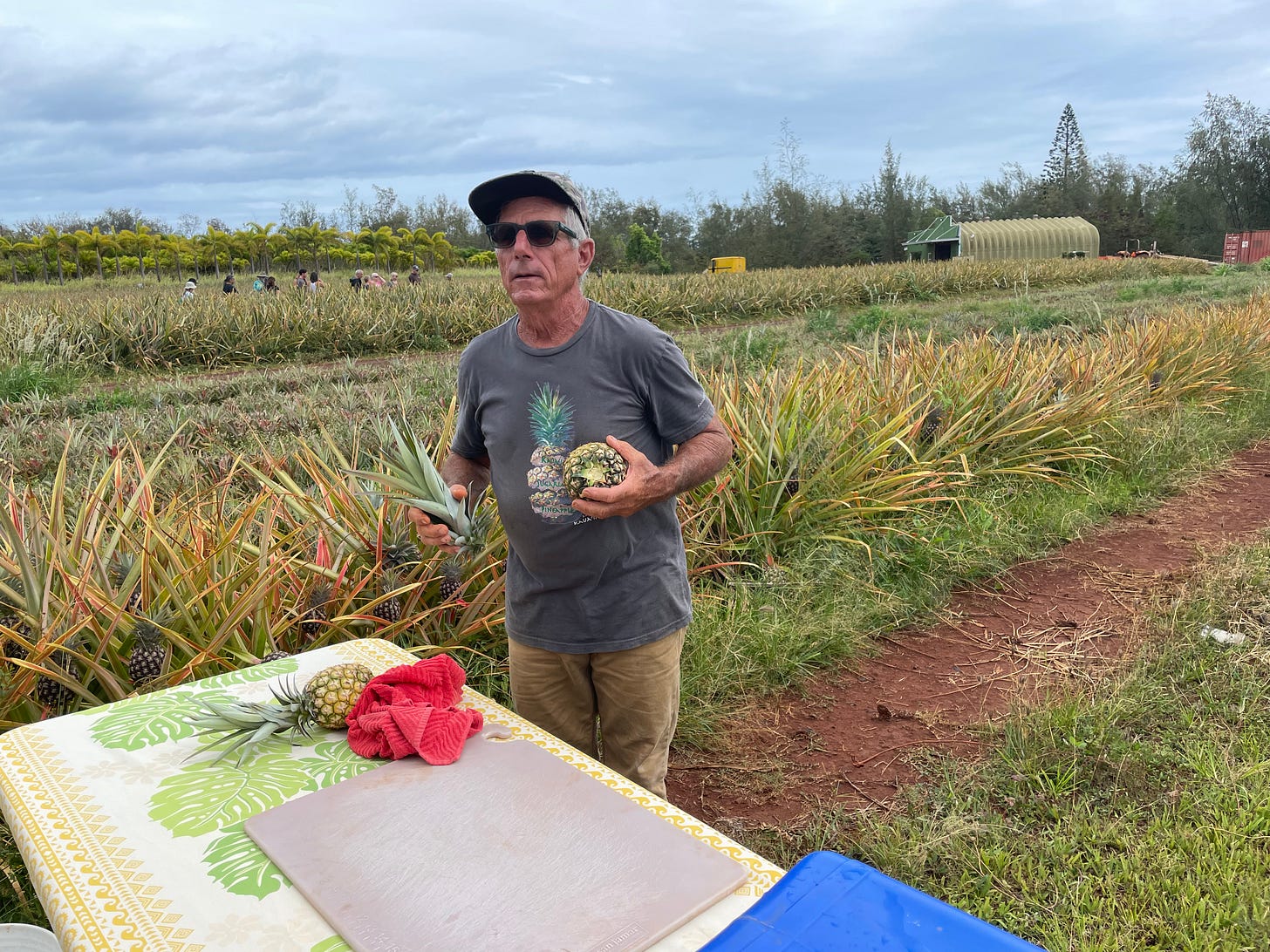I’ve waxed poetic about Sugarloaf pineapple in a previous newsletter—it’s white color, sweetness, creamy texture, and low acidity all had me at first bite.
When I discovered I could take a tour at the fruit’s birthing place I booked it immediately for the four of us: Our friends Stella and Joe, visiting from Billings, Montana, Dorothy and me.
We arrived at Jude and Paul Huber’s farm, a pleasant drive about 20 miles north of Lihue, just before 9 a.m. and signed in. After dividing the tour goers into two groups, one led by Jude, and ours by Paul, we headed out to the pineapples.
Awesome is a much overused word, but perfect for how I felt as I gazed out at 38 acres of pineapple, seeing each gorgeous fruit still attached to its plant receiving sweetening nourishment.
Here’s our guide, Paul, holding a sucker, a branch from a mature plant that will be planted to grow into another fruit-bearing plant. It takes about 18 months for a pineapple to develop.
Here are piles of suckers ready to be planted.
Row upon row of earth, plowed and ready to receive the suckers.
And here we are, each of us actually planting a sucker.
First we use that long tool to punch a hole through the plastic. Then we push a sucker into that hole to embed it firmly in the earth. Professionals can perform this step very quickly. Once planting is complete, the fields are ready to be irrigated.

As we were moving through the farm, Paul regaled us with stories about his experiences as a young man and his and Jude’s backgrounds. I could see it as a terrifically exciting miniseries!
We also learned that white pineapple arose as a mutant of yellow pineapple. But why didn’t it become a mainstay as yellow pineapple did? At the time of white pineapple’s discovery, canned yellow pineapple was king. Why? Because it withstood the grueling machine treatment that transformed the fresh fruit to canned. White pineapple, on the other hand, was the delicate princess. She sustained bruising and became mushy during canning. If it weren’t for a few prescient pineapple lovers who saw white pineapple’s potential as a fresh fruit, we wouldn’t be at Jude and Paul’s farm.
Nearing the end of our tour, Paul instructed us in how to break off a fresh pineapple from its attachment to the plant. You just grasp the fruit by its crown and jerk downward in one smooth movement and voila! You’re holding your very own freshly picked fully ripe white pineapple!
After all of us claimed our personal pineapples, Paul set up a space to cut fresh pineapples for all of us to sample.
After we had eaten our fill—I didn’t think it was possible in my case—we went into the tent area where we had signed in for yet another treat: “Sugarloaf Phrostys.”
We couldn’t believe that we were eating just frozen pineapple. Paul said it’s very easy to make. Just cut up the fruit into manageable chunks (1-inch or so) and freeze them solid on a sheet pan. Process in a food processor for less than a minute until smooth and creamy. Then dig in.
With pineapples in hand and smiles on our faces, we drove back to Lihue and chatted all the way about our great experience.
To schedule a tour—they are offered on Thursdays only and begin at 9 a.m.—you can write to sales@sugarloaf.com. The farm website is kauaisugarloaf.com. Jude and Paul call their place “Hole in the Mountain Farm.”















You will love it, Julia!
What a fun article! It brought back memories of a tour through the Maui Gold farm. I appreciate your explanation of why we don't see the white pineapple in grocery stores.